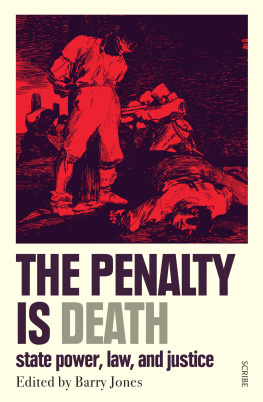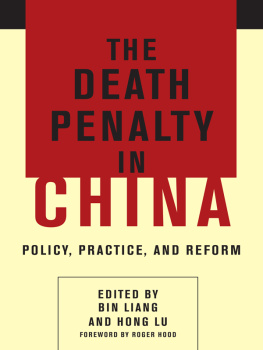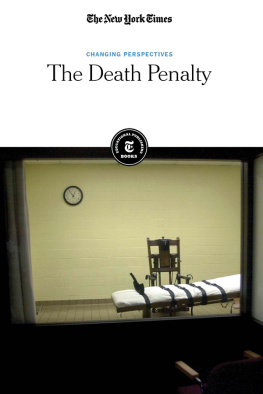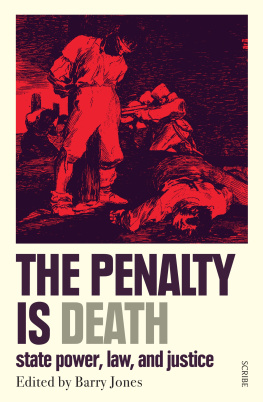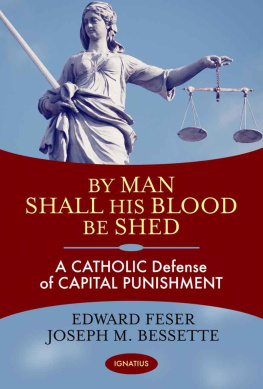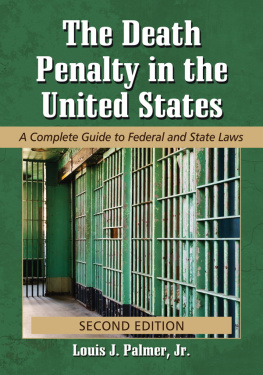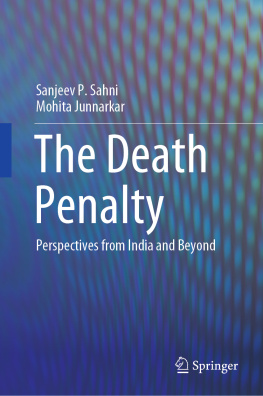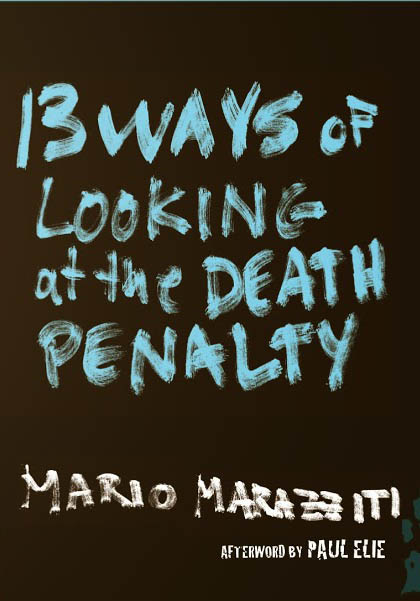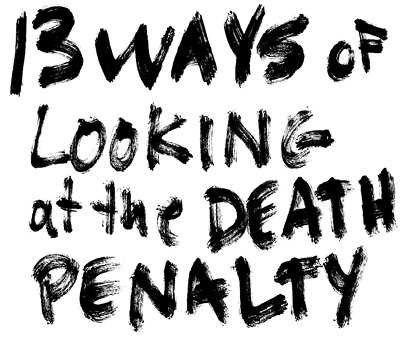Mario Marazziti
Afterword by Paul Elie
Seven Stories Press
new york oakland
Copyright 2015 by Mario Marazziti
Afterword 2015 by Paul Elie
A Seven Stories Press First Edition
All rights reserved. No part of this book may be reproduced, stored in a retrieval system, or transmitted in any form or by any means, including mechanical, electronic, photocopying, recording, or otherwise, without the prior written permission of the publisher.
Seven Stories Press
140 Watts Street
New York, NY 10013
www.sevenstories.com
College professors may order examination copies of Seven Stories Press titles for free. To order, visit http://www.sevenstories.com/textbook or send a fax on school letterhead to (212) 226-1411.
Library of Congress Cataloging-in-Publication Data
Marazziti, Mario, author.
13 ways of looking at the death penalty / Mario Marazziti ; afterword by Paul Elie.
pages cm
ISBN 978-1-60980-567-8 (hardback)
1. Capital punishment. I. Title. II. Title: Thirteen ways of
looking at the death penalty.
K5104.M37 2015
364.66--dc23
2014043858
Printed in the United States
9 8 7 6 5 4 3 2 1
Contents
Between Life and Death: Buddhism,
Hinduism, Judaism, Islam, and Christianity
by Paul Elie
Introduction
At long last, I was in San Franciscoand it was there, in the city named for St. Francis of Assisi, that I heard the news that finally made me certain that new life was still possible.
It was November 2000 and I was there for the first time, staying at a hotel called the Cathedral Hill on Van Ness, corner of Geary, for what at that time was the largest-ever gathering of anti-death penalty advocates in the US. Lance Lindsey, then the executive director of Death Penalty Focus, was there; and Richard Dieter, who runs the Death Penalty Information Center; and Sister Helen Prejean, the activist nun portrayed by Susan Sarandon in Dead Man Walking . With my friends in the Community of SantEgidio in Rome, I had become active in efforts against the death penalty. We had collected three million signatures in 152 countries calling for a worldwide moratorium. I had become acquainted with Sister Helen and through her had wound up here, as a speaker representing Europe to the National Coalition to Abolish the Death Penalty conference. I had to explain to an audience used to failure and small numbers how we had managed to collect three million signatures: You need a pen, and it takes a lot of work, I would say. There was nothing mysterious about it.
I was due to speak in a final session about strategies and the future. But something else was on my mind. At six oclock that evening, a man I knew was scheduled to die at the age of forty-foura man I had come to think of as a real friend, even as family, even though he and I had never met. His name was John Paul Penry.
Penry had been on death row in Texas ever since his conviction in 1980 for the rape and murder of a young woman named Pamela Mosley Carpenter in Livingston, East Texasthe very place where Texass death row was located. In 1989 the Supreme Court had reversed the sentence because of an apparent flaw in the case. Then Penry was retried and sentenced to death a second time. As the plane from Rome landed in San Francisco, the Texas Board of Pardons and Paroles had votedsixteen to oneagainst commuting Penrys sentence to life without parole and granting him a reprieve. Now it was time for the Texas justice system to carry out the death sentence the parole board had demanded.
The only problem was that they were executing a man who at the age of forty-four still believed in Santa Clausa man whose IQ tests ranged between fifty-three and sixty, far below the threshold of what is called intellectual disability.
How had Penrys life become intertwined with mine? My friend Gianni Guidotti, who is a doctor in Rome, had become pen pals with him, which gradually became more possible as others on death row helped Penry to write. I was reminded of some drawings Penry had sent us, so similar to my own childhood artwork: a car, a truck, a schematic housewere they third-grade, second-grade, first-grade level? Really, was the world going to be better off after eliminating our friend John?
I had already spoken to Gianni once from the conference. He had gone from Rome to Texas to meet Penry in Livingston before Penrys transfer, on the very last day, to Huntsville, where he was to be executed. Gianni had spoken with him, played with him, but it was hard for him to dispel the tension that Penry could perceive perfectly well. Penry was scared and desperate, Gianni told me in a phone call; he did not want to be put to sleep.
The second time Gianni and I spoke that day was considerably different. Gianni could hardly speak, but I understood from his joy what had happened: just three hours before he was set to die by lethal injection, Penry was given a thirty-day stay of execution pending a decision by the Supreme Court concerning a full review of the case. He had already ordered a double cheeseburger as his last meal when the news came. He never got his burger, because when the stay arrived he was immediately taken back to Livingston.
Since I was probably the first person at the conference to know that Penry had gotten a reprieve, I hastened to tell the others: Lance, and Richard, and Sister Helen, and Abraham Bonowitz from Amnesty International and the Ohio-based Movement, and a married couple from Texas, parents of a death-row inmatetheir son, they told me, had been one of those whod taught Penry to read a little and to write his own name. I vividly remember the joy of one woman, a pastor involved in restorative justice, who said, Revenge is steady and stubborn, but stupid. That is why we will win.
The next day, to conclude the conference, we marched through the streets of San Francisco, hundreds of us, each with a poster or a flag, our signs held high so that people in their cars could read them and the cable car drivers could ring their bells in support.
We marched to the pier and onto the boat that would take us to San Quentin, the site of the largest death row in America, so near to mythic San Francisco. It staggered the mind to think that the same place that gave the world Beat poetry, the Summer of Love, and psychedelic rock persists in practicing capital punishment more aggressively than most countries in the world, more so even than the worlds police states and dictatorshipseven as the rest of the world is turning away from the death penalty once and for all.
It was cold and clear that day, and I was sure itd be colder inside the prison walls. I hoped that the prisoners could hear us inside. I hoped that somehow our efforts would help to humanize the law enforcement and prison staffall those people involved in the dehumanization process that is called capital punishment or the death penalty.
All over the globein some countries more than others, to be surepeople are realizing that the state-sponsored killing of people is not worthy of our common humanity.
When the Helsinki Conference on Security and Cooperation in Europe took place in 1975an early sign of the easing of the Cold War and the strengthening of international cooperationjust sixteen countries had abolished the death penalty or committed to doing so.
By the time the Berlin Wall came down in 1989, there were nineteen more. The most prominent example was France, where in 1981 Franois Mitterand and Robert Badinter, just elected president and minister of justice respectively, took the country directly from the use of the guillotine to a radical rejection of death as punishment, abolishing it in all cases.


